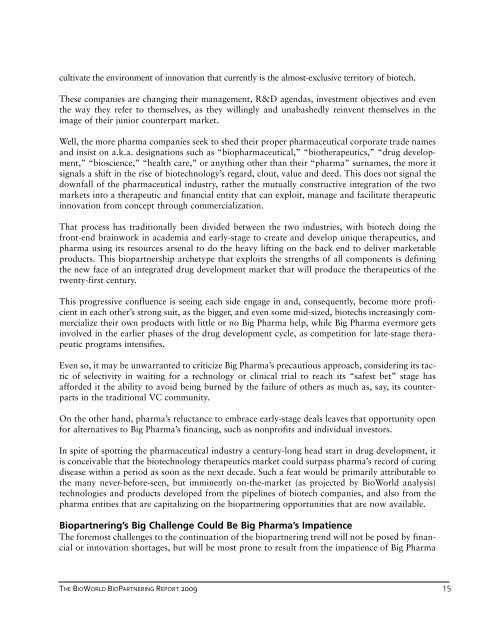BioPartnering Executive Summary - 3.qxd - Medical Device Daily
BioPartnering Executive Summary - 3.qxd - Medical Device Daily
BioPartnering Executive Summary - 3.qxd - Medical Device Daily
Create successful ePaper yourself
Turn your PDF publications into a flip-book with our unique Google optimized e-Paper software.
cultivate the environment of innovation that currently is the almost-exclusive territory of biotech.<br />
These companies are changing their management, R&D agendas, investment objectives and even<br />
the way they refer to themselves, as they willingly and unabashedly reinvent themselves in the<br />
image of their junior counterpart market.<br />
Well, the more pharma companies seek to shed their proper pharmaceutical corporate trade names<br />
and insist on a.k.a. designations such as “biopharmaceutical,” “biotherapeutics,” “drug development,”<br />
“bioscience,” “health care,” or anything other than their “pharma” surnames, the more it<br />
signals a shift in the rise of biotechnology’s regard, clout, value and deed. This does not signal the<br />
downfall of the pharmaceutical industry, rather the mutually constructive integration of the two<br />
markets into a therapeutic and financial entity that can exploit, manage and facilitate therapeutic<br />
innovation from concept through commercialization.<br />
That process has traditionally been divided between the two industries, with biotech doing the<br />
front-end brainwork in academia and early-stage to create and develop unique therapeutics, and<br />
pharma using its resources arsenal to do the heavy lifting on the back end to deliver marketable<br />
products. This biopartnership archetype that exploits the strengths of all components is defining<br />
the new face of an integrated drug development market that will produce the therapeutics of the<br />
twenty-first century.<br />
This progressive confluence is seeing each side engage in and, consequently, become more proficient<br />
in each other’s strong suit, as the bigger, and even some mid-sized, biotechs increasingly commercialize<br />
their own products with little or no Big Pharma help, while Big Pharma evermore gets<br />
involved in the earlier phases of the drug development cycle, as competition for late-stage therapeutic<br />
programs intensifies.<br />
Even so, it may be unwarranted to criticize Big Pharma’s precautious approach, considering its tactic<br />
of selectivity in waiting for a technology or clinical trial to reach its “safest bet” stage has<br />
afforded it the ability to avoid being burned by the failure of others as much as, say, its counterparts<br />
in the traditional VC community.<br />
On the other hand, pharma’s reluctance to embrace early-stage deals leaves that opportunity open<br />
for alternatives to Big Pharma’s financing, such as nonprofits and individual investors.<br />
In spite of spotting the pharmaceutical industry a century-long head start in drug development, it<br />
is conceivable that the biotechnology therapeutics market could surpass pharma’s record of curing<br />
disease within a period as soon as the next decade. Such a feat would be primarily attributable to<br />
the many never-before-seen, but imminently on-the-market (as projected by BioWorld analysis)<br />
technologies and products developed from the pipelines of biotech companies, and also from the<br />
pharma entities that are capitalizing on the biopartnering opportunities that are now available.<br />
Biopartnering’s Big Challenge Could Be Big Pharma’s Impatience<br />
The foremost challenges to the continuation of the biopartnering trend will not be posed by financial<br />
or innovation shortages, but will be most prone to result from the impatience of Big Pharma<br />
THE BIOWORLD BIOPARTNERING REPORT 2009<br />
15

















